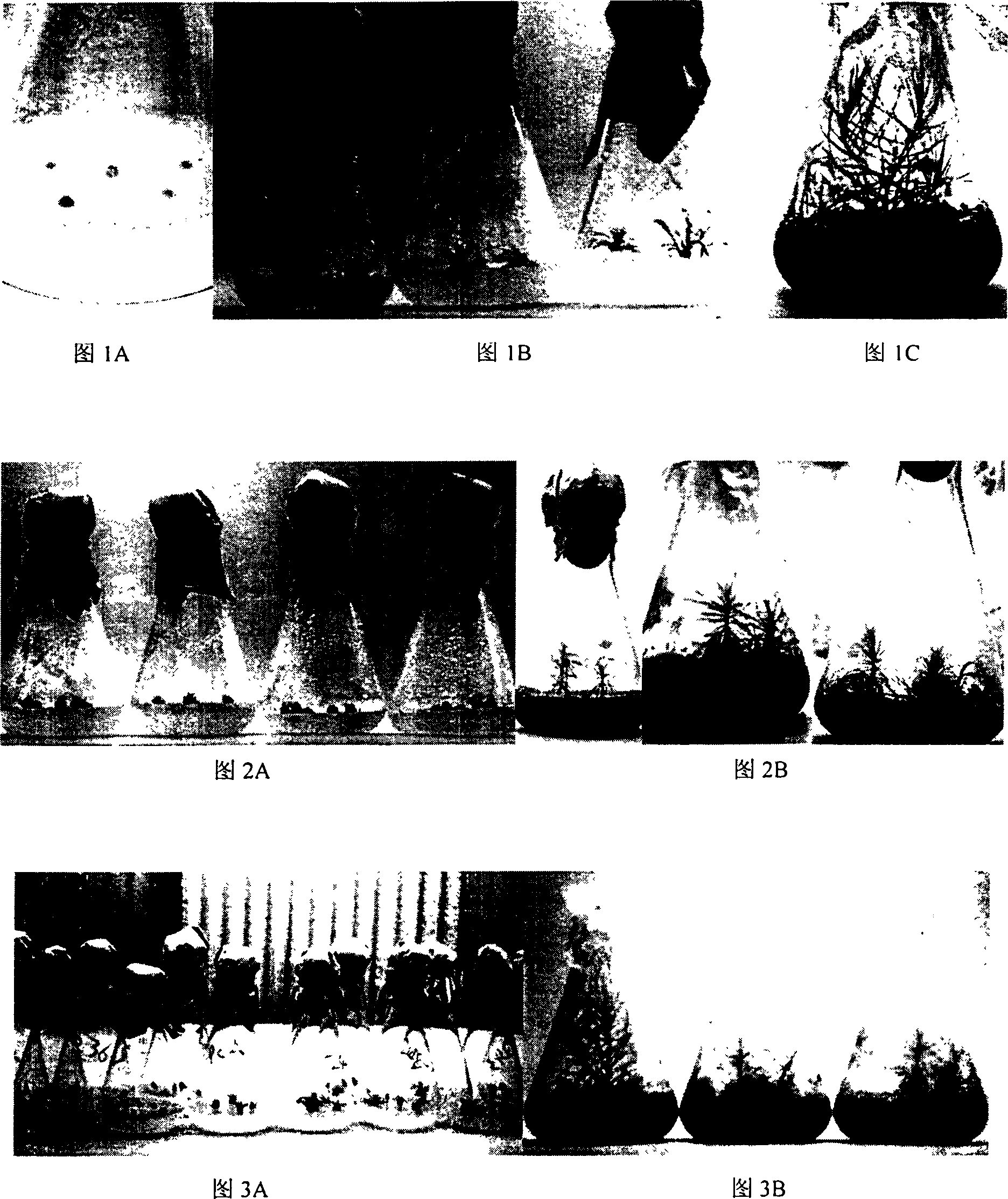Stem inductive method for microbody reproduction of Japan dahurian larch
A technology of micropropagation and larch, applied in horticultural methods, botanical equipment and methods, horticulture, etc., can solve the problems of low reproduction rate, no relevant reports on micropropagation of Japanese larch, and only focus on scientific issues, etc., to achieve High propagation efficiency, improved tissue branching and rooting rate, and fast propagation speed
- Summary
- Abstract
- Description
- Claims
- Application Information
AI Technical Summary
Problems solved by technology
Method used
Image
Examples
Embodiment 1
[0033] Select the clonal plants of Japanese larch, use the 1-year-old branch explants before bud germination in early spring as the material, take the axillary buds, adventitious stem formation, elongation induction, and subculture to realize the regeneration of stem organs; specific operations as follows:
[0034] 1. Material collection and pretreatment
[0035] The Japanese larch Chao No. 85 clone was selected from the seed garden of Wulong Forest Farm, Fushun County, Liaoning Province. The tree was 12 years old, and the middle branches of the 1-year-old tree crown were collected. The collection time was before the buds germinated in early spring. At this time, the bud scales were formed from dull Dark brown or dark brown turns into shiny light brown or light brown. Store at 4°C. After taking it out, cultivate it in water at room temperature for two weeks until the buds are bright, and set aside.
[0036] 2. Preparation of Media
[0037] 1) prepare conventional WPM medium,...
Embodiment 2
[0053] The difference from Example 1 is:
[0054] 1) Select the 28-year-old Japanese larch clone No. 38 plant, and collect 1-year-old branches full of winter buds in March as materials;
[0055] 2) Prepare the culture medium SH, the medium composition is: KNO 3 2500mg / l, NH 4 h 2 PO 3 300mg / l, CaCl 2 2H 2 O 200mg / l, MgSO 4 ·7H 2 O 400mg / l, FeSO 4 ·7H 2 O 15.0mg / l, Na 2 EDTA·2H 2 O 20.0mg / l, H 3 BO 3 5.0mg / l, ZnSO 4 ·7H 2 O 6.0mg / l, MnSO 4 4H 2 O10.0mg / l, Na 2 MoO 4 2H 2 O 0.1mg / l, KI 1.0mg / l, CoCl 2 ·6H 2 O 0.1mg / l, inositol 1000mg / l, thiamine hydrochloride 5.0mg / l, niacin 5.0mg / l, pyridoxine hydrochloride 0.5mg / l, agar 6000mg / l.
[0056] 3) Inoculation of axillary buds
[0057]Add plant growth regulating substances in the SH medium: Zea 0.2mg / l, IAA 0.5mg / l, transfer the sterilized axillary buds to the prepared Erlenmeyer flasks equipped with the SH medium, every Connect 3 to 6 axillary buds in the bottle to induce the formation of adventitious stem...
Embodiment 3
[0066] Repeat the test of embodiment 1 and embodiment 2, culture medium and culture condition are with above-mentioned respectively, the additional growth regulating substance is BA 0.1mg / l or Zea 0.01mg / l or NAA0.01mg / l in the stem induction stage, in During the stem elongation stage, IBA 0.3mg / l, NAA 0.1mg / l and AC 10g / l were taken at the beginning of April. Among the 181 axillary buds tested, 80.06% of the axillary buds completed the regeneration of stem organs. Fig. 3A, 3B, 3C, 3D show the result of above-mentioned two embodiment repeated tests, wherein Fig. 3A is the rooting culture medium of present embodiment 1, Fig. 3B and 3C are verification result of embodiment 1, Fig. 3D is present embodiment 2 verification results.
[0067] Fig. 3 is the adventitious stem in this example, indicating that the appropriate dosage of BA or Zea or NAA in the present invention alone can also complete the induction of stem (Fig. 3A) and complete the regeneration of stem organ (Fig. 3B). ...
PUM
 Login to View More
Login to View More Abstract
Description
Claims
Application Information
 Login to View More
Login to View More - R&D
- Intellectual Property
- Life Sciences
- Materials
- Tech Scout
- Unparalleled Data Quality
- Higher Quality Content
- 60% Fewer Hallucinations
Browse by: Latest US Patents, China's latest patents, Technical Efficacy Thesaurus, Application Domain, Technology Topic, Popular Technical Reports.
© 2025 PatSnap. All rights reserved.Legal|Privacy policy|Modern Slavery Act Transparency Statement|Sitemap|About US| Contact US: help@patsnap.com

